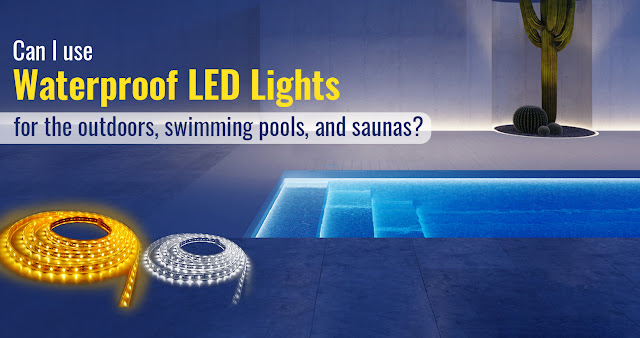Will the waterproof LED lights work in swimming pools and saunas or not? If this question strikes your mind, this is the right blog. Here, we will let you understand what to look for in the ideal waterproof LED lights and how the IP concept works.
When we talk about outdoor decorative lights, strip lights always come to our mind in first place. This is because they enhance the outdoor’s appearance by simultaneously making it visible in the dark. However, people are always concerned about whether the lights are long-lasting or not. In fact, can it bear changes in the environment was the main consideration?
Dust, dirt, and water are the 3 main elements that can sabotage the LED strip lights if they are not waterproof. So, you must look for the IP rating of the lights that you are purchasing. Unfortunately, not every IP rating indicates that the lights are waterproof LED lights. You have to check that on your own. Not just that, each IP rating indicates different protection facts. So, you must do your homework before purchasing waterproof LED strip lights.
What thing indicates that the lights are waterproof LED lights?
Waterproof technology seems to be a boon in everyone’s life. It is helping us in more than one way. Earlier, things that were not waterproof tended to die immediately when they came in contact with water. But since they are waterproof now, there s nothing to worry about their life anymore.
Mobile phones, smart watches, earphones, strip lights, etcetera are the perfect example of waterproof technology. If we talk about waterproof strip lights, they are secured inside an airtight fixture that does not let water or dust enter inside and damage the lighting diode.
IP rating plays a vital role in indicating LED lights' dust and waterproof capability. There are 3 basic IP ratings that LED lights usually come with. IP-20 (no protection), IP65 (water-resistant), and IP-68 (water-proof) are the ratings that say about the end result of lights if they come in contact with water.
What is the IP-rating concept?
IP is a term that stands for “Ingress Protection.” This term is used to declare the protection of a lighting fixture against solid agents like dust & sand, and water. An IP rating has 2 digits, the first one indicates solid object protection, and the second one shows liquid protection.
Solid protection
The first digit in the IP rating ranges from 0-6, where 0 shows absolutely no protection against solid objects, and 6 is the highest protection against dirt, dust, debris, or human touch. So the highest range you got, the more protection your strip lights will have.
Liquid protection
This is the second digit of an IP rating that ranges from 0-8. The more the rating, the safer these lights will be if exposed to moisture content sites. Here, 0 shows no liquid protection, and 8 is completely water-proof lights.
Differentiation between water-resistant and waterproof LED lights
One must check for the IP rating if he thinks water-resistant and waterproof LED strip lights are the same. There is a minor but necessary difference between these two terms that you must know about. A water-resistant light is indicated with an IP65 rating, whereas an IP68 rating shoes a completely waterproof LED light. Both lights are protected against solid interference, but you must pay attention to the water's involvement.
Lights with an IP65 rating are eligible for water interference, but one should not dunk them in water. On the other hand, lights with an IP68 rating are eligible for water protection even if they are dunked inside a swimming pool.
If you are not planning to use your LED strip lights in locations that are moisture prone, then opting for a lower IP rating light will be enough. However, using waterproof LED strip lights becomes a necessity when outdoors are involved. Since the chances of moisture and other harsh environmental conditions are always on the deal with outdoor locations, you are bound to choose waterproof lights only.
IP65-rated lights can effortlessly work in rainy or windy weather, but IP68-rated ones can be used underwater. So when looking for lights that can thrive underwater, you must choose IP68-rated lights.
Following are the locations where waterproof LED lights are recommended to use:
Swimming pool & hot tub
LED strip lights are used underwater inside swimming pools or hot tubs to increase visibility. Simultaneously, it looks phenomenal when the edges light up during the night. People liked the way these lights turned out. This is the reason behind the popularity of underwater lights.
Lights with an IP68 rating will effortlessly work underwater and be safer if you accidentally touch them barehanded.
A locked steam room
People prefer going to steam rooms or taking sauna baths for their body rejuvenation. This is an excellent way to release stress from the body. Unfortunately, the temperature inside these rooms results in extreme vapor pressure that can affect the lights. But if you will go with waterproof LED lights, you will eliminate the chances of malfunction.
LED strip lights that are completely waterproof enhance the sauna’s environment and promote longevity. They can endure steam, vapor, and humidity pretty easily.
Outdoor lighting purposes
If you are cautious about using waterproof LED lights outdoors, you must know that they are safer to use in open environments. They can retain their illumination capacity in harsh weather conditions. Dust, dirt, or rain cannot ruin their performance. So, you can use IP68-rated strip lights for terraces, porches, patios, entryways, gardens, etcetera.


Comments
Post a Comment